The 50th anniversary of the Apollo 11 mission which took man to the moon is fast approaching, and the story will be retold many times – but what are the secrets that people aren't really aware of?
Sky News has created an interactive Apollo 11 article for readers to find out about the enormous technological advances over the course of that half century since the mission.
The mission itself was the single greatest test of human bravery and ingenuity which has ever taken place – and you can read our anatomy of what happened during that test.
But conspiracy theories abound about the Apollo programme, from the wildly misplaced claim it was faked, through to the confirmed involvement of the CIA, although probably not for the reason you'd think.
Read on as Sky News sheds some light on the dark side of the moon landings and the programme behind them.
Advertisement
11. There were plans to abandon the astronauts on the moon
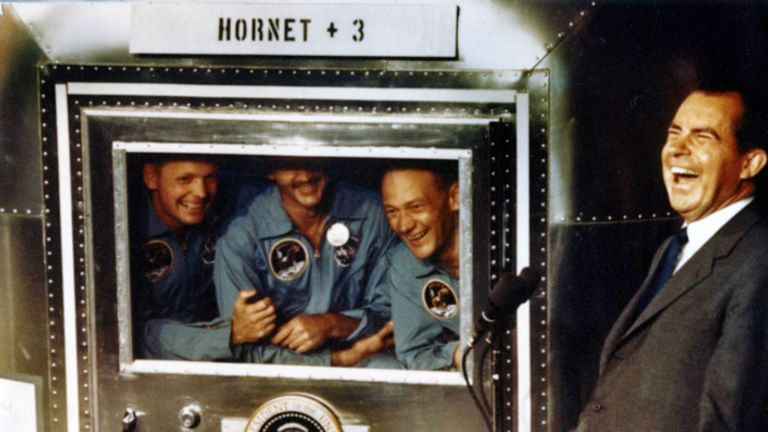
For the Apollo 11 mission a speech had been prepared for President Nixon titled "In the Event of Moon Disaster" to be read on television in case the astronauts were stranded on the moon.
According to the plans for the – fortunately unfulfilled eventuality – Mission Control was to stop communicating with the astronauts. The president would have telephoned each of the widows-to-be, and then make the following speech:
"Fate has ordained that the men who went to the moon to explore in peace will stay on the moon to rest in peace.
"These brave men, Neil Armstrong and Edwin Aldrin, know that there is no hope for their recovery. But they also know that there is hope for mankind in their sacrifice.
"These two men are laying down their lives in mankind's most noble goal: the search for truth and understanding.
"They will be mourned by their families and friends; they will be mourned by their nation; they will be mourned by the people of the world; they will be mourned by a Mother Earth that dared send two of her sons into the unknown.
"In their exploration, they stirred the people of the world to feel as one; in their sacrifice, they bind more tightly the brotherhood of man.
"In ancient days, men looked at stars and saw their heroes in the constellations. In modern times, we do much the same, but our heroes are epic men of flesh and blood.
"Others will follow, and surely find their way home. Man's search will not be denied. But these men were the first, and they will remain the foremost in our hearts.
"For every human being who looks up at the moon in the nights to come will know that there is some corner of another world that is forever mankind."
10. The moon smells
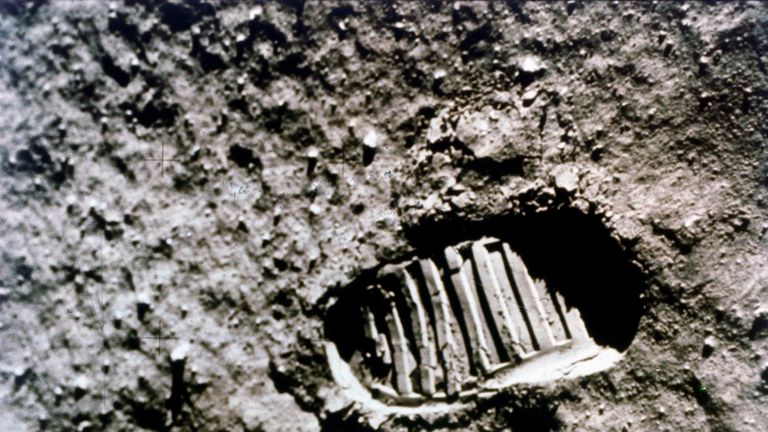
Jack Schmitt, the last man to ever walk on the moon as part of the Apollo 17 mission, reported that "everyone's instant impression of the smell was that of spent gunpowder".
"Not that it was 'metallic' or 'acrid'. Spent gunpowder smell probably was much more implanted in our memories than other comparable odours," he added.
It has since been suggested that this smell was caused by the astronauts' nasal membranes reacting to the highly electrically charged lunar dust – something which Schmitt himself supposed, as a trained scientist.
9. It became a race issue

Race and class were tightly intertwined topics in America in the 60s and 70s, especially when it came to the motivations and concerns of the civil rights movement.
Two years after the murder of Dr Martin Luther King in 1968 and a year after the 1969 moon landing, poet and activist Gil Scott-Heron released his response to Armstrong's famous claim that the Apollo 11 mission marked a "giant leap for mankind" with a visceral poem about the economic hardship ordinary people, especially black people, were facing:
A rat done bit my sister Nell.
(with Whitey on the moon)
Her face and arms began to swell.
(and Whitey's on the moon)
I can't pay no doctor bill.
(but Whitey's on the moon)
Ten years from now I'll be paying still.
(while Whitey's on the moon)
Access to healthcare insurance remains a contentious political debate in America 50 years on.
8. The crew had to sign customs declarations when returning to the US

The laws of nature proved surmountable to the Apollo 11 crew, but nothing gets past US Customs – the three astronauts had to declare that they were importing moon rock and moon dust samples.
Well, they didn't really have to. NASA officials have stated that it was a bit of a little joke between the agencies – but the declaration is completely authentic and was made shortly after the crew splashed down in the middle of the Pacific Ocean.
7. The flag was accidentally knocked over
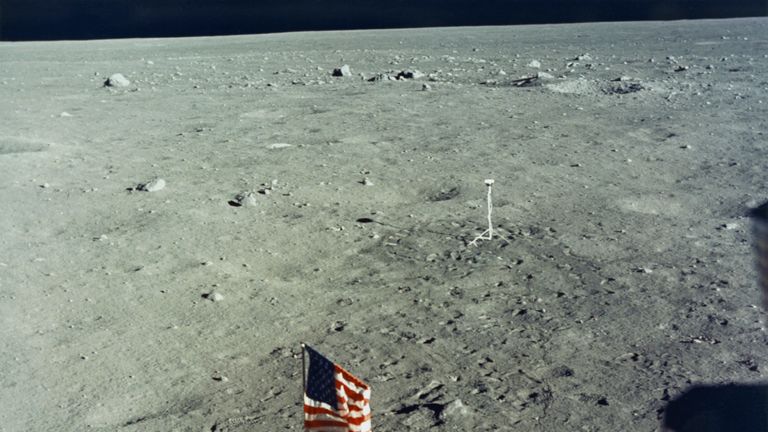
As the Eagle lander lifted up from the surface of the moon the exhaust from its engine caused the American flag to topple over – although not before Armstrong snapped a picture of it.
All of the subsequent Apollo missions planted the flag much further from the landing module.
Contrary to suggestions that the solar wind helped keep the flags upright and fluttering, they were fitted with small extendable poles to try and keep them in shape.
6. Armstrong broke the switch to the circuit breaker and Aldrin used a pen to save them
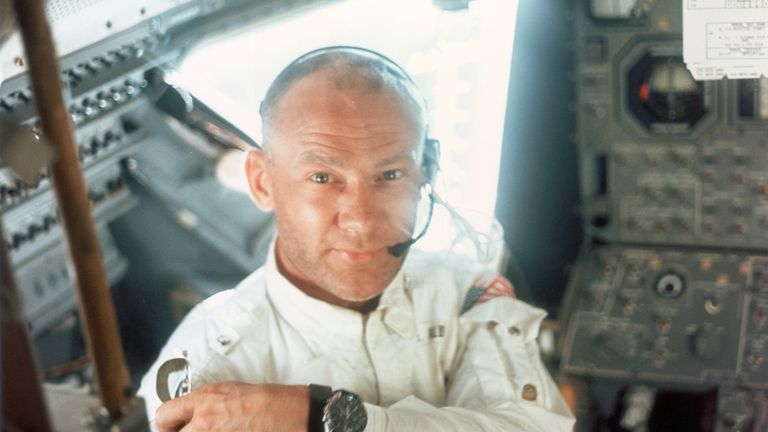
When Armstrong and Aldrin got back into the lunar module, Armstrong accidentally bumped into the circuit breaker switch with the bulky life support system in the backpack of his suit.
The switch was essential to activate the module's ascent engine which would have flown them up into orbit where they would board again with the command module that would take them back to Earth.
Unfortunately, he broke it off, potentially stranding them on the moon.
Forced by circumstance to improvise, Aldrin found a pen which he used to engage the circuit breaker and trigger the ascent engine. It worked and the pen is now on display at the Museum of Flight in Seattle.
5. One of the astronauts believed in aliens
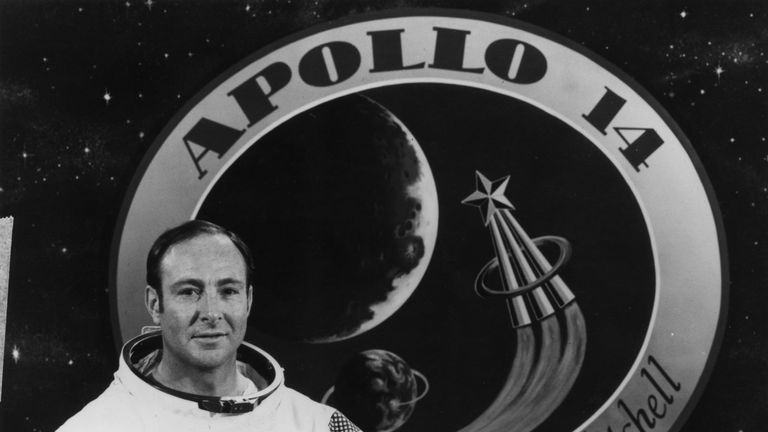
Edgar Mitchell, the lunar module pilot for Apollo 14, publicly stated he was personally 90% sure that many reports of unidentified flying objects, or UFOs, "belong to visitors from other planets".
He suggested that he had met officials from foreign countries who had personal encounters with alien beings, and suggested that governments were covering up such contacts.
However he always maintained that he had never seen a UFO, and that he had never been threatened regarding those claims. He also said that UFOs being covered-up was his own personal speculation.
4. The original tapes of the Apollo 11 landings are missing

The original tapes of the Apollo 11 moon landing have been missing for decades, alongside hundreds of boxes of magnetic tape holding Apollo programme data.
This, of course, has encouraged conspiracy theorists – with little evidence supporting any claims that the tapes were stolen by the Soviets, or destroyed because they contained evidence the landings were faked.
On the 40th anniversary of the Apollo 11 launch the international team attempting to locate the tapes reported that they believed they had been accidentally reused and overwritten.
However, during their search for the original tapes they did find copies which were of a higher quality than anything which had been in the public domain before. NASA subsequently released about three hours of this restored footage.
3. The Apollo 17 rover waRead More – Source [contf] [contfnew] 
Sky News
[contfnewc] [contfnewc]






